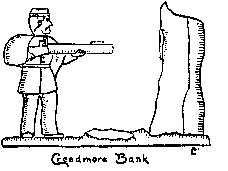COLLECTORS ROUNDUP — October 1946
The Mechanical Banker
by Richard M. Lederer, Jr.
How many different mechanical banks are there? Because there are so many ways of counting, it is difficult to say how many banks there are. Some people count the varieties as separate banks. Descriptions of many banks have appeared although the banks themselves cannot be found, and there is still hope that a few may exist. Some designers’ models of banks, never commercially made, are in collectors’ hands and are considered in the total. Several of those who have published lists of banks have done so with superficial investigation of the subject and have included many names of banks which are duplications, the same bank being known by different names to several researchers. Being presumptuous, perhaps, I would say that a list of basic types would not number more than 280 banks. This number does not include varieties, proofs, semi-mechanicals or registering banks.
 By
"varieties" we mean those banks essentially the same, yet differing in
some degree, from the basic type. Varieties occurred by accident, by changes in
design made by different manufacturers and by changes made from time to time by
the same producer to improve mechanics and design. The Creedmore Bank, showing a
Civil War soldier shooting a penny into a tree, has one variety in which the
soldier wears a bayonet and blanket roll. The Volunteer Bank is often mistaken
for the Creedmore as it appears similar, but the different name is cast in the
base. The Grenadier Bank appears closely the same, but the soldier’s cap has a
visor and it too has the different name cast in. On some published lists one
finds the GAR Bank and the Civil War Soldier Bank. Collectors are agreed that
these are merely different names for the Creedmore and not other banks. I feel
that mentioned above are 3 basic types and one variety. How do you count these?
Differences in paint can be found, but most collectors do not consider these to
be separate varieties. A change brought about one day when a man with a paint
brush decided to trade the colors of a jacket and a pair of pants is not as
important as a change in the casting mold. There must be at least 150-200
recognized varieties in existence.
By
"varieties" we mean those banks essentially the same, yet differing in
some degree, from the basic type. Varieties occurred by accident, by changes in
design made by different manufacturers and by changes made from time to time by
the same producer to improve mechanics and design. The Creedmore Bank, showing a
Civil War soldier shooting a penny into a tree, has one variety in which the
soldier wears a bayonet and blanket roll. The Volunteer Bank is often mistaken
for the Creedmore as it appears similar, but the different name is cast in the
base. The Grenadier Bank appears closely the same, but the soldier’s cap has a
visor and it too has the different name cast in. On some published lists one
finds the GAR Bank and the Civil War Soldier Bank. Collectors are agreed that
these are merely different names for the Creedmore and not other banks. I feel
that mentioned above are 3 basic types and one variety. How do you count these?
Differences in paint can be found, but most collectors do not consider these to
be separate varieties. A change brought about one day when a man with a paint
brush decided to trade the colors of a jacket and a pair of pants is not as
important as a change in the casting mold. There must be at least 150-200
recognized varieties in existence.
Many banks appearing on published lists are questionable. Some such as Barnyard Animals, Boy Playing Marbles, Charlie Knickerbocker, Croquet Players, to name a few, are believed never to have been made. Some others, Battleship Massachusetts, Flatiron Building and General Butler, for example, are "stills." Cabin Bank, Cart and Horse, Clown and Elephant, and Horse Race are some which appear twice under these and other names. The Man on Chimney, Forty-Niner, English Tobacco Bank and Miser are not banks at all, but cigar cutters, a vending machine and a change purse. The Blacksmith Bank is the working model formerly owned by the late James C. Jones. This was the proof made by Frederick Plattner in 1905, but the bank was never commercially manufactured.
Very few of the patentees gave names to the banks they designed, apparently leaving that to merchandising men. John Hall, the father of cast iron mechanical banks, included the names "The Tammany Bank" and "Race Course Toy Bank" in the papers patenting these items, James Butler christened one of his the "Panorama Bank" and it is still known by this name although another name might have been more appropriate. Many banks have wording cast into them and it is generally by this name that they are known, rather than by the name given them by the jobber or patentee. Darktown Battery was called Baseball Bank by L. H. Mace & Co. in their 1894 catalogue. Calamity was intended to be called Football Bank by its patentee, James N. Bowen. In the original patent papers, Russel Frisbie, head of J. & E. Stevens Co., specifically calls his bank "William Tell," but Selchow & Righter called it "Tyrolese Bank" in their jobbers’ catalogue. We now know it by its original name. The Trolley Bank, as we call it, has "Motor Bank" cast in the side. The patentee, A.C. Rex, showed it that way and Conway Bros., jobbers, called it Motor Bank. Hobbyists changed its name because it looks like a trolley car, yet to have left it would have made identification simpler.
